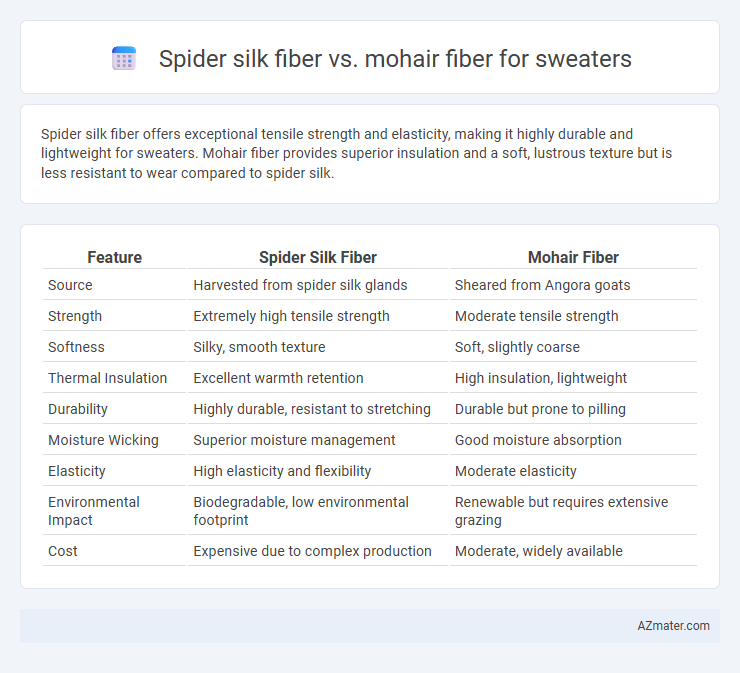Spider silk fiber offers exceptional tensile strength and elasticity, making it highly durable and lightweight for sweaters. Mohair fiber provides superior insulation and a soft, lustrous texture but is less resistant to wear compared to spider silk.
Table of Comparison
| Feature | Spider Silk Fiber | Mohair Fiber |
|---|---|---|
| Source | Harvested from spider silk glands | Sheared from Angora goats |
| Strength | Extremely high tensile strength | Moderate tensile strength |
| Softness | Silky, smooth texture | Soft, slightly coarse |
| Thermal Insulation | Excellent warmth retention | High insulation, lightweight |
| Durability | Highly durable, resistant to stretching | Durable but prone to pilling |
| Moisture Wicking | Superior moisture management | Good moisture absorption |
| Elasticity | High elasticity and flexibility | Moderate elasticity |
| Environmental Impact | Biodegradable, low environmental footprint | Renewable but requires extensive grazing |
| Cost | Expensive due to complex production | Moderate, widely available |
Introduction to Spider Silk and Mohair Fibers
Spider silk fiber, renowned for its exceptional strength-to-weight ratio and natural elasticity, offers a lightweight yet durable option for sweater fabrics. Mohair fiber, harvested from the Angora goat, is prized for its softness, sheen, and excellent thermal insulation, providing warmth and a luxurious feel in garments. Combining these fibers can create sweaters that balance durability, comfort, and aesthetic appeal.
Origins and Production Processes
Spider silk fiber originates from the secretions of spiders, harvested through genetic engineering or bio-farming techniques to replicate natural silk proteins, ensuring sustainability and biodegradability. Mohair fiber, derived from the Angora goat primarily found in South Africa, United States, and Turkey, is produced by shearing the goats biannually, then cleaning, carding, and spinning the fibers into yarn. Spider silk production involves advanced biotechnology to create fibers with exceptional strength and elasticity, while mohair harvesting relies on traditional animal husbandry and mechanical processing for softness and luster.
Physical Properties Comparison
Spider silk fiber exhibits exceptional tensile strength and elasticity, making it one of the toughest natural fibers for sweater construction. Mohair fiber, derived from the Angora goat, is renowned for its smooth texture, high luster, and excellent thermal insulation but has lower tensile strength compared to spider silk. Both fibers offer lightweight and breathable characteristics, with spider silk providing superior durability and mohair excelling in softness and warmth retention.
Strength and Durability
Spider silk fiber exhibits exceptional tensile strength, surpassing that of mohair fiber, making it an ideal choice for durable sweaters. Mohair fiber, derived from the Angora goat, offers moderate strength but excels in softness and elasticity rather than toughness. The superior resilience and lightweight nature of spider silk contribute to longer-lasting, high-performance sweater fabrics compared to traditional mohair options.
Softness and Comfort
Spider silk fiber offers exceptional softness and superior moisture-wicking properties, resulting in a lightweight and breathable sweater that enhances comfort throughout prolonged wear. Mohair fiber, derived from the Angora goat, provides a luxurious, silky texture with excellent insulation, which keeps the body warm but may feel slightly coarser compared to spider silk. Both fibers contribute to high-end sweaters, but spider silk excels in softness and breathability, while mohair is prized for warmth and durability.
Thermal Insulation and Breathability
Spider silk fiber offers superior thermal insulation due to its finely structured protein chains that trap heat efficiently while remaining lightweight. Mohair fiber, derived from Angora goats, provides excellent breathability and moisture-wicking properties, making it ideal for regulating body temperature in fluctuating conditions. Combining the thermal retention of spider silk with the air permeability of mohair creates a balanced sweater fabric optimized for comfort in both cold and warm environments.
Eco-Friendliness and Sustainability
Spider silk fiber offers exceptional eco-friendliness due to its biodegradability and minimal environmental impact during production, relying on renewable biological processes without harmful chemicals. Mohair fiber, sourced from Angora goats, is sustainable when harvested responsibly, as it is a natural, renewable material with excellent durability and moisture-wicking properties but requires significant water and land resources for goat farming. Comparing the two, spider silk fiber stands out for its potential in sustainable luxury textiles with lower ecological footprint, while mohair remains a traditional natural fiber with moderate environmental considerations.
Dyeability and Color Retention
Spider silk fiber exhibits superior dyeability due to its protein structure, allowing vibrant and long-lasting colors on sweaters. Mohair fiber, derived from Angora goats, has moderate dye absorption but tends to fade faster under UV exposure and frequent washing. The molecular composition of spider silk contributes to better color retention and resistance to fading compared to mohair in textile applications.
Maintenance and Care Requirements
Spider silk fiber requires minimal maintenance due to its natural resistance to water, dirt, and UV rays, making it ideal for lightweight, durable sweaters that retain shape and color longer. Mohair fiber, derived from the Angora goat, demands gentle care including hand washing or dry cleaning and careful storage to prevent matting and pilling, as its fine, lustrous fibers are more prone to damage. Proper care of mohair garments ensures softness and resilience, while spider silk sweaters benefit from easy-to-clean properties that reduce the frequency of washing.
Cost and Market Availability
Spider silk fiber commands a significantly higher price due to its rare and labor-intensive production process, making it a luxury material rarely found in mainstream sweater markets. Mohair fiber, sourced from Angora goats, offers a more affordable and widely available alternative with established supply chains supporting large-scale textile manufacturing. Market availability favors mohair for sweater production because of its consistent quality, cost-effectiveness, and accessibility compared to the niche, premium spider silk fiber.

Infographic: Spider silk fiber vs Mohair fiber for Sweater
 azmater.com
azmater.com